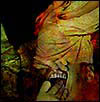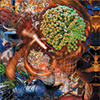

Afterlife DNA Fingerpainting
(Melon Expander - ME003) CD $13.50
When Points of Friction formed in January of 1981, they had no formal musical training (or even knowledge of freely improvised music) and relied on their voices and whatever else was at hand -- wire mesh, sheet plastic, an old guitar, etc. Gradually the group acquired electric instruments, toy keyboards, multi-track tape recorders, and pedal effects, and moved toward a more processed sound, informed by groups such as Faust, Cluster, Nurse with Wound, Dome, This Heat, Can, AMM, Fripp and Eno, and Negitivland. After a 20-year hiatus Joseph Hammer, Damian Bisciglia (Agog), Tim Alexander, and Kenny Ryman reformed with Mitchell Brown and dropped this, their third official release.

Sprinkle Of Blunder
(Chocolate Monk - choc.600) CD $14.00
“Even on occasions absent slide dissolves and the multiple super-8 projections that ornament their live shows, Points of Friction have remained an audio-visual group since their inception. Listen to Sprinkle of Blunder in complete darkness, and notice if your sponge doesn’t require a good firm squeeze by the end. Is anyone else seeing the mad flashes of painted film, hand-scratched emulsions, layers of transparent material, and magnified vegetation? Good, so we agree, then. The late 2011 session that gives us this album progressed from dark energy to its current state on the material plane much as others before it: Joseph Hammer, Mitchell Brown, Tim Alexander and Damian Bisciglia gathered informally in remote locations where acoustical situations were presumed to exist, waiting and ever-welcoming to seekers and freaks, like a tunnel or an abandoned bakery once owned by a crab-faced character actor from the 1940s. They did a bit of recording together, saved the results to their respective devices, and then played them at various moments during the recording session proper — in this case at Brown’s Los Angeles studio. Around these and other field recordings each had made on his own, Sprinkle of Blunder pulsates at every intersection of Brown’s synth, Hammer’s tape loops, and the hoarder’s paradise of objects, prepared instruments, toys, hot-wired and damaged goods that Alexander and Bisciglia considered their axes. But let’s not forget that the seamlessness of their entangled montages makes accounting for precisely what is being done by whom at any given moment superfluous. Curiosity might not kill the cat but it’s not going to clean its puke off the carpet, either. However we diagnose the root cause of our cognitive maladies, we know they need to be cured with a nuance-rich antidote free of side effects. Points of Friction’s model of the subconscious flows and jars with sublime finesse. It has a life-force all its own, flickering back and forth between the primal states identified in Goethe’s Theory of Gunk (gooey, gaseous and gelatinous) — one big thing ready to be absorbed. But, fair enough, knowing the constituent parts of what’s going into our bodies is an overriding concern of the times. How about this: metal sculptures, bristles, vocalizations, banjo, harmonica, effects processing, sampling, loops, zither, rubber trumpet, badge reel with clock spring, Speak’n’Math, spin whistle, synthesizers, keyboards, drums, field recordings, loops, tape loops, and tape loop manipulation. Mmmmmm, information…. so enlightening. At 12 tracks in 57 minutes, it’s more of a holistic, live-in-the-studio recording than a pharmaceutical confection (though just as sinfully rich as your Aunt Twiggy’s figgy pudding). As with any 600-piece jigsaw puzzle, once assembled in the correct combination, the mosaic is complete. Bisciglia in particular was certain right away that these recordings were suitable for release, and as such it has been in the works for a decade since his passing. It arrives not without a bit of after-the-fact touch up, minor editing, crafting, tailoring — sure. Listening to the master recordings of the jams, Alexander, Brown, and Jay Morales pinpointed certain themes or modalities, not all of which moved in a straight line. They didn’t hesitate to relocate bits and pieces that made sense elsewhere as a transition between two parts of a completely different track. Ultimately it’s the overall mood that connects everything, accounts for the continuity and internal logic, keeps it all related.” Order this item from from Tedium House and receive a complimentary copy of Bananafish #15, which includes an interview with Damian Bisciglia.